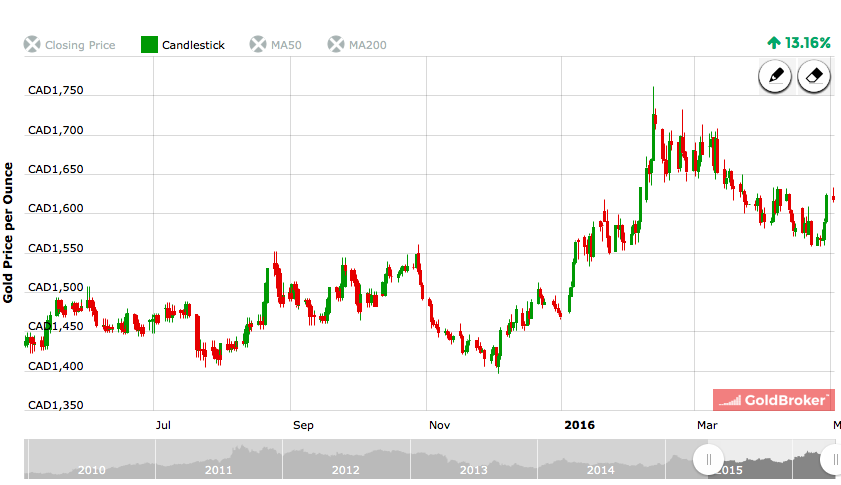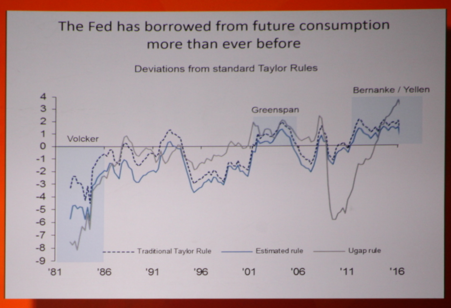Currency
Druckenmiller also agreed that negative rates are “absurd”, said that he is bearish stocks, and concluded by revealing what his biggest currency allocation is. “Some regard it as a metal, we regard it as a currency and it remains our largest currency allocation” he said, without naming the metal.
We know what he was talking about. Gold.
Along with the currencies of most other commodity-exporting countries, the Canadian dollar has been in near-freefall lately.
Gold, meanwhile, has been sucked down with the rest of the commodities complex, falling hard since 2013. But only in US dollars. For Canadians, with their weak domestic currency, gold has been behaving just fine. It’s up 25% in C$ terms over the past 17 months.

Protection from currency trouble is why people own it, and why in the vast majority of places its owners are very happy.
For an excellent review of the Gold Market be sure to read Clive Maund’s Gold Market Update – Money Talks Ed
In 1967 the Jefferson Airplane sang:
“When the truth is found to be lies,
And all the joy within you dies…”
Restating this for economies and global currencies, one might say:
 When the truth is found to be lies,
When the truth is found to be lies,
Confidence in currency dies.
WHAT LIES? Really? There have been so many. Here are a few examples specific to the United States (the lies in other countries are probably similar):
Lyndon Johnson: In 1965, after decades of excessive government expenditures which caused rising consumer price inflation and rising gold and silver prices, Johnson removed silver from U.S. coins. He stated,
“If anybody has any idea of hoarding our silver coins, let me say this. Treasury has a lot of silver on hand, and it can be, and it will be used to keep the price of silver in line with its value in our present silver coin. There will be no profit in holding them out of circulation for the value of their silver content.”
He lied. One hundred dollars purchased 77 ounces of silver in 1965. A decade later $100 purchased 24 ounces of silver. Four decades later $100 purchased 13 ounces of silver. In 2025 $100 will probably purchase less than one ounce of silver.
Richard Nixon, the gold window, and Watergate: In 1971 President Nixon “temporarily” rescinded the agreement to convert US dollars submitted by foreign governments for gold. He stated,
“Let me lay to rest the bugaboo of what is called devaluation… But if you are among the overwhelming majority of Americans who buy American-made products in America, your dollar will be worth just as much tomorrow as it is today. The effect of this action, in other words, will be to stabilize the dollar.”
On Watergate: He stated:
“I had no prior knowledge of the Watergate operation.I took no part in, nor was I aware of, any subsequent efforts that may have been made to cover up Watergate.”
He lied regarding both topics. One thousand dollars purchased 24 ounces of gold in 1971. A decade later $1,000 purchased 2.2 ounces of gold. Four decades later $1,000 purchased 0.6 ounces of gold. In 2025 $1,000 will probably purchase about 0.1 ounces of gold.
Devaluing currencies are normal for our debt based fiat currency financial system. But, when leaders, especially Presidents, are caught in lies, the populace is more inclined to “wake up” and see the reality of corporate and banking control over government policies. Those lies weakened the narrative that the government is run by the people, for the people, and is beneficial to the people. A loss of confidence in leaders leads to a loss of confidence in the country, its institutions, and accelerates the decline of the currency.
When the truth is found to be lies,
Confidence in currency dies.
Political Lies:
- Kennedy Assassination: There were so many lies, cover-ups, and strange deaths that hundreds of books have been written on the subject.
- Lyndon Johnson and the Vietnam War: He escalated the Vietnam War based on the “Gulf of Tonkin Incident,” a story that was fabricated.
- Edward Kennedy’s role in Chappaquiddick: More of the same…
- Bill Clinton regarding Monica Lewinsky and other infidelities: “I did not have sexual relations with that woman.” The House impeached him for perjury but the Senate did not convict. Politics as usual…
- Hillary Clinton: Oh my, let’s not go there.
- President Obama regarding Obamacare: “If you like your health plan you can keep it.” Clearly not true … and confidence in the Presidency has decreased, for this and many other reasons.
WHAT IS THE POINT?
- Of course politicians lie to protect their re-elections, reputations, positions, assets, and cronies. If politics did not “pay” so well, we would seldom hear about politicians, their lies, and the corruption, which will continue.
- Of course central bankers and Wall Street “manage” the narrative. They have $trillions to protect and they want their skim from the economy to continue. Not likely to change …
- Of course politicians and central bankers will distract the populace with “free stuff” rather than adult discussion. Politicians and central bankers will not discuss massive and unpayable debts, higher taxes, decreased military spending, reduced entitlements, and pervasive corruption. One does not get elected by telling voters they will have less and their “sacred cows” must be sacrificed to benefit the military and banking interests. Expect more promises, distractions, scandals, and a higher cost of living.
But we can change our understanding of the process and our actions to protect ourselves.
- If the President’s actions are largely dictated by corporate, banking, and military interests, does it really matter who is elected? Of course it matters to those on the receiving end of the money distributed by the government. Otherwise politicians and corporations would not spend $ billions to purchase the Presidency.
- The US dollar has lost approximately 98% of its purchasing power since 1913, and the dollar will continue to weaken, not strengthen, following more devaluations and lies (and we will have more lies). Given the necessity of devaluation and the ongoing lies, we should expect a much weaker dollar during the next decade. Would gold, silver, diamonds, hard assets, land, and fine art be preferable to unbacked paper currencies or bonds yielding negative interest rates?
- Hemmingway: “The first panacea for a mismanaged nation is inflation of the currency; the second is war. Both bring a temporary prosperity; both bring a permanent ruin.”
Our former Presidents have warned us by obviously lying about the dollar, gold, silver, health care, sexual indiscretions, unemployment, inflation, and wars. More revelations are coming …
When the truth is found to be lies, Confidence in currency dies.
Gary Christenson
The Deviant Investor
Related: What Gold Does In A Currency Crisis Canadian Edition
The Fed has been trying to promote inflation. That is not the guy with the tin foil hat speaking, it is direct from FOMC statements targeting a higher inflation level, which is another way of saying they are targeting a lower US dollar level. From this we leaned toward that which would benefit from a declining USD. Precious metals (led by silver) are a prime beneficiary, with oil and some commodities remaining firm despite pressure on stock markets as corporate performance and economic signals continue to fade.
Interestingly, the Bank of Japan played a big role in the ‘inflation trade’ last week as Kuroda signaled, temporarily at least, that it was the US’s turn to devalue in the global game of currency Whack-a-Mole in which BoJ was a star figure for so long. In one week, the US Fed rolled over and played dead (again) and the Bank of Japan surprised markets by refusing to intensify its ongoing inflationary operation.
One wonders how well coordinated these policy bodies are. Recall that while BoJ and ECB were softening global investors up to the idea of globally pervasive negative interest rate policy (NIRP), the US Fed was (in my opinion) pretending to be a beacon of sound policy in making a pathetic move of +1/4 on the Fed Funds Rate. Now that Goldilocks has long-since left the story, the Fed can pop its head up and promote inflation itself, with the BoJ mole standing down. Here is a chart of JPY/USD overlaid with gold and silver…

related:
Of all the crazy market action in the 2007-09 housing meltdown and Great Recession, you know what stands out the most? The fact crude oil prices rocketed to all-time highs.
Between January 2007 and July 2008, crude oil prices almost tripled from $51 a barrel to $147 a barrel. This happened even though the stock market was plunging … the housing market was imploding … banks and brokers were tumbling toward failure … and the global economy was slipping into its worst recession in decades.
Why would that happen? How did that make any sense from a rational standpoint? Well, consider what happened to the U.S. DOLLAR during that same time.
The DXY, or U.S. Dollar Index, tracks the performance of the greenback against a basket of six foreign currencies. The euro has the highest weight at just under 58%, followed by the Japanese yen, British pound, Canadian dollar, Swedish krona and Swiss franc.
As you can see in this chart, the DXY started falling off the table at the beginning of 2007. It ultimately tanked from around 85.50 to 71.40. That was the lowest level for the DXY since it was created in 1973.
Sure enough, the move in crude oil is a veritable mirror image. It’s worth noting that other “contra-dollar investments” like gold also took off like a rocket. The yellow metal jumped in price by around $400 an ounce to more than $1,000 an ounce.
That brings me to today. We’ve just seen the failure of the Doha production talks. Iran is jacking up production, threatening a Saudi response. The U.S. is still churning out millions of barrels per day more oil than it did a few years ago (though down from the peak). The latest data suggests the U.S. economy is stumbling badly.
Yet oil just rallied more than 60% off its low in the mid-$20s. And perhaps not coincidentally, the DXY has been wilting right alongside — falling from around 100 in December to 94 this week. It now sits on the edge of a potentially serious breakdown, with some currencies like the Japanese yen really on fire against the buck.
Now I’m not saying the dollar and crude have to move in lockstep again. But it’s worth noting that gold is on fire this year, surging just like it did back in 2007-08. And even though some pundits on Wall Street might tell you otherwise, I don’t think a surge in crude would be bullish for stocks overall.
It sure wasn’t last time, as you know. Stocks imploded in 2007 and 2008. The surge in oil also helped push a struggling U.S. economy even deeper into recession by driving the cost of things like gasoline through the roof.
So if I had to sum up my thoughts, I’d put them this way:
- The dollar looks increasingly vulnerable here. I’ve been long the Japanese yen, and one of my other favorite “safety” currencies, in a couple of my services. They could really explode in value if the dollar falls off the table.
So watch the critical 93 level on DXY to see if that technical support gives way. In the meantime, click here if you want to know what to buy and why in an era of weaker U.S. growth and a major credit market turn.
- Crude could jump if that happens. But if it does so because of the dollar tanking … and the dollar is tanking because the U.S. economy is tumbling toward recession … that sure doesn’t sound like a recipe for higher stock prices.
The only companies that would likely prosper would be my safe yielding, lower-volatility, less economically sensitive gems. Again, you can click here to watch “The Unseen Hand” — and find out how to get specific recommendations.
- One of the best plays would be gold and gold miners. You don’t get the high level of economic/recession risk that oil comes with. But you do get protection against a plunge in the buck, insane monetary policy worldwide, and a blow out in risk spreads or stock market decline.
If you’re looking for more specific suggestions not just from me, but from a trio of noted gold experts, whom I’ve been working closely with — then consider the Money, Metals, & Mining Cruise. It’s scheduled to sail July 10-17, 2016, on board the Crystal Serenity from Anchorage to Vancouver. You can find out more information here, or by calling 800-797-9519 and asking for the special cruise rates that apply.
Bottom line: It’s a mad world out there. But clues to today’s market moves may be found from thelast major market and economic bust.
Until next time,
Mike Larson

















